About Us
History of Corydon Palmer
The Corydon Palmer Dental Society was established on March 10, 1913, when the Youngstown Dental Society called a meeting of dentists in Columbiana, Trumbull and Mahoning counties to organize a component of the Ohio State Dental Society.
It was agreed that the society’s name would honor one of the leading pioneers in dentistry, a Trumbull County native, Dr. Corydon Spencer Palmer.
Dr. Palmer was born in Vernon on January 12, 1820. At age 16, he became apprenticed to a silversmith in Warren; during the four years of his apprenticeship he also studied dentistry by “picking up” knowledge from other dentists. In 1839, he opened his first office, in Warren; he was 19 years old.
He soon became known for his inventiveness in the field of dental instruments. He became a member of the board of trustees and a teacher of operative dentistry in the Ohio College of Dental Surgery, which conferred upon him the honorary degree of Doctor of Dental Surgery. He was active in organized dentistry, including the Ohio State Dental Society, the Mississippi Valley Association of Dental Surgeons, and the American Dental Association.
In 1843 he traveled to New York to become an engraver, but instead joined Dr. John Burdell in the practice of dentistry. Utilizing his twin skills, he invented the first complete set of instruments for the manipulation of cohesive gold foil. The story is told about him that he once malleted a string of gold beads for a relative using pure gold foil; a jeweler who examined the beads said they were an expert work of art.
His firsts in the profession were many: he invented clamps to use in applying the rubber dam in difficult cases; he taught his own method of putting crowns on roots and building up contours; he pioneered the use of carbolic acid to soothe sensitive cavities before filling and the use of tin foil for inexpensive fillings.
After his return to Warren, patients came from as far as New York to be treated by him; the most prominent were the Vanderbilt family, who traveled in their special car on the Erie Railroad or sent a special car to carry him and his equipment to New York.
An ardent abolitionist, Dr. Palmer was admired for his dedication, inventiveness, artistic ability, genius and extreme modesty.
He died at the age of 97 on February 17, 1917, at the home of his son, Dr. Delos Palmer, in New York, and is buried in Oakwood Cemetery, Warren. The dental society that bears his name continues to dedicate itself to meeting the standards he set.
Dr. Palmer's Legacy
Perhaps the widest renown Dr. Corydon Palmer achieved came from his creation of what has become known as "Palmer notation," a system used by dentists to associate information to a specific tooth. Although superseded by the FDI World Dental Federation notation in the United States, it continues to be used by orthodontists, dental students and practitioners in the United Kingdom.
The Palmer notation consists of a symbol (┘└ ┐┌) designating in which quadrant the tooth is found and a number indicating the position from the midline. Adult teeth are numbered 1 to 8, with deciduous teeth indicated by a letter A to E. Hence the left and right maxillary central incisor would have the same number, "1", but the right one would have the symbol, "┘", underneath it, while the left one would have, "└".
With the move from written dental notes to electronic records, some difficulty in reproducing the symbols was encountered. On a standard keyboard 'slash' and 'backslash' may be used as an approximation to the symbols with numbers placed before or afterwards; hence 3/ is 3┘ and /5 is ┌5 .
If you are reading this on a computer, you can read the whole article.
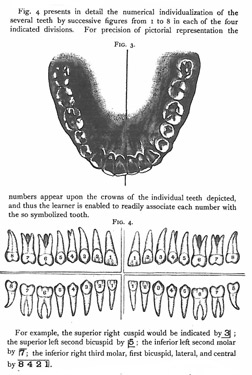
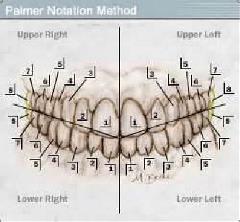
100 Years Of Caring
Corydon Palmer Dental Society celebrated its 100th birthday in 2013. Our observance of this once-in-a-lifetime event began with our January installation ceremony, when then-ADA President, Dr. Robert Faiella, installed the "Centennial Year" officers, including our 100-year president, Dr. Donald Brunetti.
We invited the public to celebrate our milestone year, with a series of TV messages that highlighted our "100 Years of Caring" for families in our membership area: Mahoning, Trumbull and Columbiana counties. The TV campaign consisted of announcements and quarterly interview segments on WFMJ's 6 p.m. news, highlighting the public service CPDS members perform as part of OPTIONS, Give Kids a Smile, and Access Health Mahoning Valley.
And in 2014, we launched our Second Hundred Years of Excellence – we've got plans!
Fun Facts
The meeting will come to order…
Each January, during our annual Installation Ceremony, the retiring president of the Corydon Palmer Dental Society literally "hands over the gavel" of leadership to the incoming president.
This is no ordinary gavel. Our meetings are "rapped" to order by a marble gavel, hand-engraved for us by the late Dr. David Liddle, a dedicated member and an avid student of dental history.
Our gavel, in which the engraved lettering "3-10-1913 CPDS," our founding year, is filled in with molten gold, was the second gavel to be personalized by Dr. Liddle, who practiced out of an office in the former Union Savings & Trust building in downtown Warren and was a member of the Warren Dental Society and, as were many members of the group, also a member of the Corydon Palmer Dental Society.
Dr. Liddle was the first orthodontist to graduate from the University of Pittsburgh School of Dentistry, in 1920. In 1967, Dr. Anthony Antolini, "fresh from the Navy," hung out his shingle in Warren and joined the Warren group. He remembers meeting Dr. Liddle, who was at the time working on engraving a marble gavel for that society. Dr. Liddle had an amazing manual technique, his contemporaries remember, and he filled in the engraved portions of his gavel with molten gold dental wire. The date on that gavel is very worn, but is likely 1925.
It was suggested to Dr. Liddle that he might like to make a similar gavel for the Corydon Palmer group, which was the comprehensive society representing Trumbull, Mahoning and Columbiana counties dentists. He agreed, and the finished new gavel soon came into our hands.
When the Warren group dissolved, the original gavel was given for safekeeping to Dr. Bernard Dusza; after his passing, his wife presented it to Dr. Antolini to give to our group. So we now have the distinct honor of preserving both pieces for posterity!
Following the real trail of Dr. Corydon Palmer
In 2013, Corydon Palmer Dental society celebrated its 100th anniversary. As part of our year-long celebration, we set out to follow the footprints of the renowned dentist for whom we are named.
We wanted to find his birthplace, which we knew to be in Vernon Township, and his Warren office, where he practiced before and after a sojourn in New York City. After some painstaking research, we thought we had done just that: a pioneer-era home on Ohio Route 7 in Vernon, across from the Badger School, is on the exact spot that the old Trumbull County maps identify as the property of Warren Palmer, the doctor's father, at the time of Corydon Palmer's 1820 birth.
And in Warren, we researched some very old city directories, following the trail of shifting street-number practices, from what started out as Number 10 Washington Street right to the door of today's 166 Washington Street NE – which turned out to be the present-day office of Dr. Gust Charnas!
Dr. Gust Charnas at his office, 166 Washington Street NE, generally considered to be the original office of Dr. Corydon Palmer.
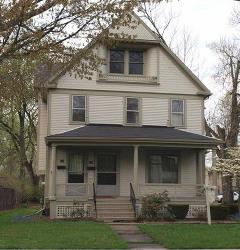 Dr. Charnas confirmed our research. Dr. David Liddle had told him, when he first bought the house some 50 years ago, that it was Corydon Palmer's old office. "But I was young, and those things weren't important then," Dr. Charnas said.
Dr. Charnas confirmed our research. Dr. David Liddle had told him, when he first bought the house some 50 years ago, that it was Corydon Palmer's old office. "But I was young, and those things weren't important then," Dr. Charnas said.
The Queen Anne Victorian home is located in what would have been Warren's most fashionable neighborhood when Dr. Palmer practiced there, in the 1880s. The old carriage house, where Dr. Liddle once wrote about visiting, and where Dr. Palmer was said to have created his own implements and honed his jeweler's craft on a hand-fired forge, is still there, complete with the haymow doors and feeding chute for the horse!
Dr. Charnas offers the home to the Society: The owners of both buildings gave their permission for us to place memorial plaques, which the Executive Office accomplished early in 2014. Shortly afterward, Dr. Charnas decided to retire, and generously offered his office as a gift to our Society.
But questions arose when we studied the county's records for the property. Strangely, it showed that the house had been built in 1921. But Dr. Palmer had passed away in 1917! Obviously, Dr. Charnas's charitable gesture had made it clear that more research was needed.
Finally, in the Warren Public Library's genealogy room, we came upon an old newspaper clipping. Dated 1941, it described the sale of the "little brown cottage" that had been Dr. Corydon Palmer's office, and the new owner's plans to move the building to the East Side of town.
Dr. Palmer's actual home and office, at 164 Washington Street NE in Warren, no longer exists
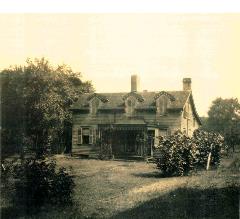 Fred Brainard, who owned Brainard Freight Lines, said he planned to move the little house to a property he owned on Fairmount Avenue and rent or sell it. There is no trace of it on that street today.
Fred Brainard, who owned Brainard Freight Lines, said he planned to move the little house to a property he owned on Fairmount Avenue and rent or sell it. There is no trace of it on that street today.
The cottage, at 164 Washington, had apparently occupied a small lot next to the property at 166 Washington; it may have been a side lot. The newspaper article even described that famous laboratory, not in a back building at all:
In the kitchen is a ceiling high kiln, said to have been built by the doctor himself. Constructed of cement and slate and heated with charcoal, dentures were probably baked in it. As Dr. Palmer made many of his own instruments they may well have been annealed in this kiln.
The article went on to note that the house may not have been built on that location, but moved from somewhere else, perhaps from Park Avenue a block or so away.
So we must content ourselves with knowing we have marked Dr. Palmer's birthplace, and also the property, if not the actual building, where he practiced his profession. Dr. Charnas has retired, and the Society, while acknowledging the house's historical value, has regretfully passed on accepting ownership.
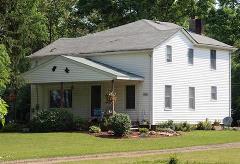
Yet, as the trail to the actual property is grown over with time, the reputation of its stellar occupant never dims. As the Tribune story notes, "The Corydon Palmer Dental Society … perpetuates the doctor's name in the profession."

